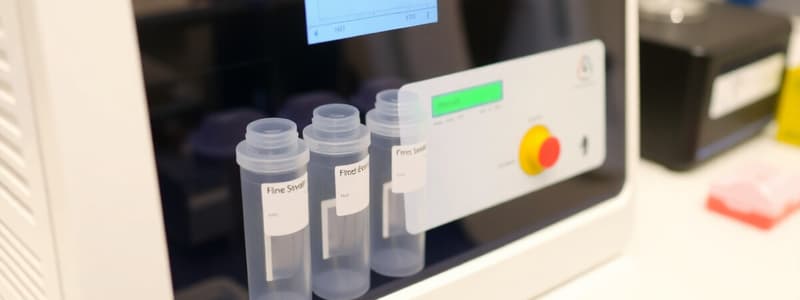Podcast
Questions and Answers
What are the names of the three ways that a test strip analysis can be performed?
What are the names of the three ways that a test strip analysis can be performed?
- Manual, Semi-Automated, Fully Automated (correct)
- Manual, Semi-Automated, Fully Automated (correct)
- Manual, Semi-Automated, Fully Automated (correct)
What does the abbreviation 'AUBF' stand for?
What does the abbreviation 'AUBF' stand for?
Analysis Of Urine And Body Fluids
The Aution Hybrid AU-4050 urine analyzer is a semi-automated system.
The Aution Hybrid AU-4050 urine analyzer is a semi-automated system.
False (B)
What is the name of the instrument used to measure refractive index?
What is the name of the instrument used to measure refractive index?
Mie Theory explains that the amount of light scattered or reflected is directly proportional to the size of the molecule.
Mie Theory explains that the amount of light scattered or reflected is directly proportional to the size of the molecule.
Flashcards
Quality System (QS)
Quality System (QS)
All the laboratory policies, procedures, and resources necessary for quality testing, including QC, pre-examination, examination, and post-examination variables.
Quality Assessment (QA)
Quality Assessment (QA)
Methods used in a laboratory to ensure high-quality patient care and a regulated testing system.
Internal QC
Internal QC
Quality control methods performed within a laboratory to ensure the accuracy and reliability of its processes.
Internal QC
Internal QC
Signup and view all the flashcards
Electronic QC
Electronic QC
Signup and view all the flashcards
Proficiency Testing
Proficiency Testing
Signup and view all the flashcards
Manual Urine Analysis
Manual Urine Analysis
Signup and view all the flashcards
Automated Urine Analysis
Automated Urine Analysis
Signup and view all the flashcards
Semi-Automated Urine Analysis
Semi-Automated Urine Analysis
Signup and view all the flashcards
Fully Automated Urine Analysis
Fully Automated Urine Analysis
Signup and view all the flashcards
Photometry
Photometry
Signup and view all the flashcards
Refractometry
Refractometry
Signup and view all the flashcards
Turbidimetry
Turbidimetry
Signup and view all the flashcards
Reflectance Photometry
Reflectance Photometry
Signup and view all the flashcards
Laser Flow Cytometry
Laser Flow Cytometry
Signup and view all the flashcards
Automated Urine Analyzer Key Features
Automated Urine Analyzer Key Features
Signup and view all the flashcards
Disadvantages of Manual Method
Disadvantages of Manual Method
Signup and view all the flashcards
Study Notes
Analysis of Urine and Body Fluids
- Objectives: Define quality assessment components in AUBF, differentiate internal QC types, explain automated urine analysis principles, distinguish manual, semi-automated, and fully automated methods, and enumerate automation advantages.
- Quality Assessment: Guarantees quality patient care through a regulated total testing system. Includes quality control (QC), pre-examination variables (specimen collection, handling, storage, reagent status, instrument calibration, maintenance, personnel requirements, and technical competence), examination variables (test performance, reporting of results), and post-examination variables (interpretation, turn-around time, documentation, and accreditation by agencies like JC, CAP).
- Quality System (QS): Adheres to ISO 9001:2008, ISO 14001, and ISO 27001 standards for quality assurance, environmental management, and information security.
- Introduction to Automation: Automation in urine analysis has a long history, starting with Hippocrates.
- Ancient History: Hippocrates hypothesized urine as a humors' filtrate, and Galen refined this, suggesting it reflected overall body condition. Theophilus Protospatharius wrote about urine, and then Johannes de Ketham developed a self-diagnostic color wheel.
- Modern History: Jules Maumené developed the first test strip, George Oliver marketed urinary test papers, Fritz Feigl developed spot analysis techniques, and later, urine test strips became commercially available on a large scale. Automated analyzers and Combur-Test strips followed.
- Three Automated Methods: There are three methods for performing automated urine analysis.
- Manual: The test is done entirely by hand. A strip is dipped into urine and compared to a chart.
- Semi-Automated: The test strip is dipped into urine manually but the analysis is done by an instrument.
- Fully Automated: The test is completely done by an instrument.
- Fully Automated Analyzers The sample is mixed, aspirated, diluted, and stained to analyze urine sediment particles. These systems perform complete physical, chemical, and microscopic analysis of urine.
- Principles of Automation: Photometry (measuring light), reflectance photometry (intensity of light reflection, inversely proportional to concentration), and turbidity (measurement of decreased light penetration due to suspended particles).
- Laser Flow Cytometry: Uses two fluorescent dyes to stain cellular elements, analyzes cell size, and internal cell structure, can differentiate bacteria.
- Refractometry: Measuring refractive index.
- Factors Influencing Light Scatter: Particle size, particle concentration, wavelength, molecular weight, polarization of incident light, and distance of observation affect light scattering.
- Automated Systems for Urine analysis: Various manufacturers produce automated analyzers, for both chemistry and microscopy
- Advantages of Automation: Minimizes labor, frees up operators, improves accuracy, and standardization.
Automated Analyzer Types
- Chemistry analyzers: Semi-automated and fully automated systems that use test strips for analyzing urine chemistry components.
- Microscopy analyzers: Fully automated systems that analyze urine sediment using microscopy.
- Hybrid systems: Systems that combine both chemistry and microscopy analysis in one unit.
Manual, semi-automated, and Fully Automated Testing Procedures
- Manual procedures: Briefly dipping test strips in urine, blotting, and comparing colors to charts.
- Semi-automated procedures: Dipping strips in hand, placing onto reagent platforms, and pressing the analysis button on the machine.
- Fully automated procedures: Test strips placed in the machine, automatically dipped, and analyzed, giving results in seconds.
Studying That Suits You
Use AI to generate personalized quizzes and flashcards to suit your learning preferences.
Related Documents
Description
This quiz covers the quality assessment components in automated urine and body fluid analysis. You'll learn about various quality control types, automated analysis principles, and the advantages of automation in testing. Delve into the quality systems set by international standards for improved patient care.




